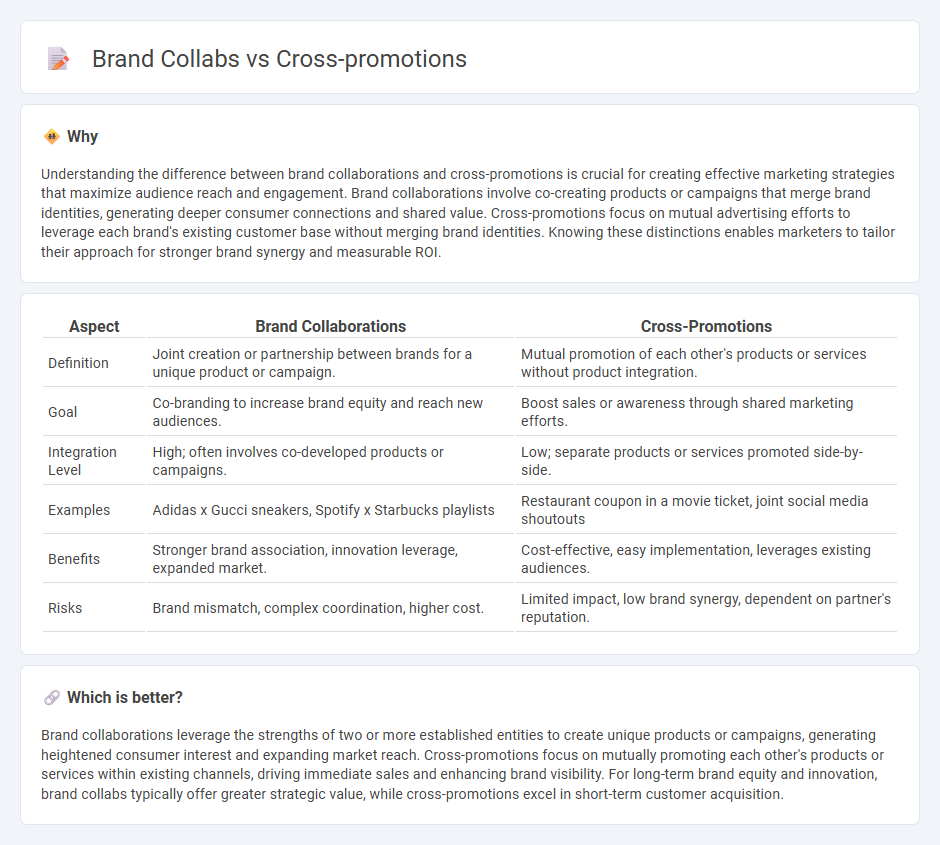
Brand collaborations merge identities of two or more companies to create unique products or campaigns, enhancing brand equity and market reach effectively. Cross-promotions involve promoting complementary products or services from different brands to boost customer engagement and sales through mutual support. Discover how leveraging these marketing strategies can elevate your business impact and audience connection.
Why it is important
Understanding the difference between brand collaborations and cross-promotions is crucial for creating effective marketing strategies that maximize audience reach and engagement. Brand collaborations involve co-creating products or campaigns that merge brand identities, generating deeper consumer connections and shared value. Cross-promotions focus on mutual advertising efforts to leverage each brand's existing customer base without merging brand identities. Knowing these distinctions enables marketers to tailor their approach for stronger brand synergy and measurable ROI.
Comparison Table
| Aspect | Brand Collaborations | Cross-Promotions |
|---|---|---|
| Definition | Joint creation or partnership between brands for a unique product or campaign. | Mutual promotion of each other's products or services without product integration. |
| Goal | Co-branding to increase brand equity and reach new audiences. | Boost sales or awareness through shared marketing efforts. |
| Integration Level | High; often involves co-developed products or campaigns. | Low; separate products or services promoted side-by-side. |
| Examples | Adidas x Gucci sneakers, Spotify x Starbucks playlists | Restaurant coupon in a movie ticket, joint social media shoutouts |
| Benefits | Stronger brand association, innovation leverage, expanded market. | Cost-effective, easy implementation, leverages existing audiences. |
| Risks | Brand mismatch, complex coordination, higher cost. | Limited impact, low brand synergy, dependent on partner's reputation. |
Which is better?
Brand collaborations leverage the strengths of two or more established entities to create unique products or campaigns, generating heightened consumer interest and expanding market reach. Cross-promotions focus on mutually promoting each other's products or services within existing channels, driving immediate sales and enhancing brand visibility. For long-term brand equity and innovation, brand collabs typically offer greater strategic value, while cross-promotions excel in short-term customer acquisition.
Connection
Brand collaborations and cross-promotions enhance marketing strategies by combining the strengths and audiences of two or more brands to amplify reach and engagement. These partnerships create unique value propositions, leveraging each brand's identity and consumer base to drive mutual growth and increase customer loyalty. Metrics such as increased social media engagement, expanded market share, and boosted sales demonstrate the effectiveness of such synergistic marketing efforts.
Key Terms
Audience Synergy
Cross-promotions leverage complementary audiences by sharing distinct but related products or services to boost mutual visibility and engagement. Brand collaborations merge identities to create unified campaigns that amplify reach and deepen emotional connections across overlapping target demographics. Explore the strategic benefits of audience synergy to maximize impact in your marketing efforts.
Co-branding
Cross-promotions involve partnerships where two brands promote each other's products or services separately, while brand collaborations, especially co-branding, integrate brand identities to create a new combined product or experience. Co-branding leverages the strengths and customer bases of both brands to enhance market presence and consumer appeal, often resulting in unique offerings that neither brand could achieve alone. Discover how strategic co-branding can amplify your brand's reach and innovation potential.
Value Exchange
Cross-promotions leverage the strengths of two or more brands to mutually increase exposure and customer reach by sharing marketing channels and audiences, creating a direct value exchange in visibility and engagement. Brand collaborations often involve deeper integration, combining product elements or co-creating new offerings, which results in a more substantial and lasting value exchange through innovation and enhanced brand equity. Explore the nuances and strategic benefits of these partnerships to maximize your marketing impact.
Source and External Links
What Is Cross-Promotion and How to Cross-Promote - Cross-promotion is a partnership marketing strategy where two or more businesses promote each other's products or services, using tactics like co-hosted webinars, partner discounts, social media collaborations, bundle deals, and referral programs for mutual benefit.
Cross-promotion - Cross-promotion is a marketing method where related products or services promote each other simultaneously, reducing promotion costs and creating win-win partnerships such as brand tie-ins or co-branded offers, commonly used by companies like Disney and Burger King.
How to Cross-Promote on Social Media (+ Proven Strategies) - Cross-promotion on social media involves collaborative endorsements to tap into trust and reach wider audiences, exemplified by partnerships like Nike and Apple or Starbucks and Spotify, focusing on mutual support rather than just content sharing.
 dowidth.com
dowidth.com